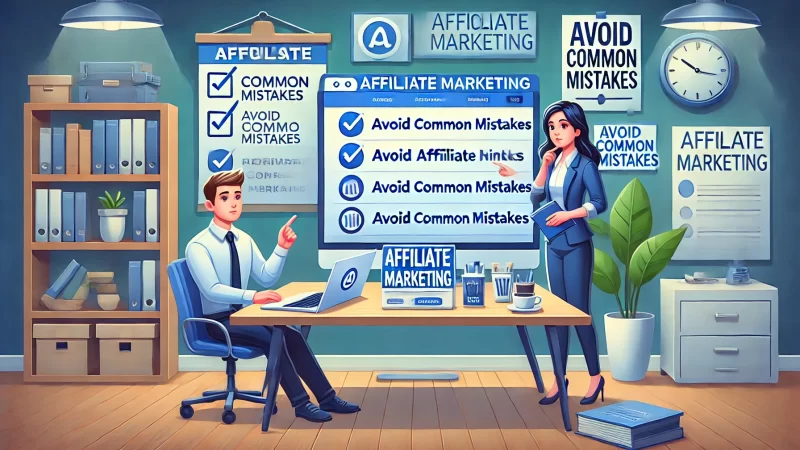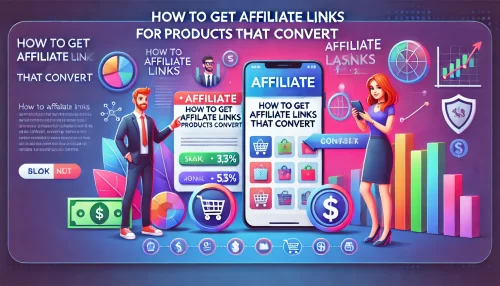Table of Contents
Are you wondering how to create affiliate links that boost your earnings, drive traffic, and track sales effectively?
In this guide, we’ll explore the strategies and tools for creating optimized affiliate links, so you can start monetizing your content efficiently. Whether you’re new to affiliate marketing or looking to improve your results, understanding these essentials will help you succeed.
Understanding Affiliate Links Basics
Affiliate links are essential tools in digital marketing, connecting users with recommended products or services and allowing creators to earn a commission. Understanding these links’ purpose, function, and benefits is crucial for maximizing affiliate marketing success.
What Are Affiliate Links and How They Work
Affiliate links are unique URLs that track referrals from one website to a merchant’s site, rewarding the affiliate for conversions. When someone clicks your affiliate link and makes a purchase, you earn a commission. I find these links effective because they allow seamless promotion without intrusive ads, directly linking your audience to products they may need.
Each link contains a unique identifier, tracking your impact and ensuring commissions are credited accurately. Knowing how these links work enables you to use them strategically and optimize your earnings over time.
Affiliate marketing relies on cookies, which track the user after they click an affiliate link. Cookies typically last from 24 hours to 30 days, depending on the affiliate program. This tracking period allows the affiliate to earn commissions even if the user doesn’t make an immediate purchase.
I suggest familiarizing yourself with each platform’s cookie duration to understand your potential earning window. This knowledge can guide your promotional strategies effectively.
Affiliate links are widely used in blogs, social media, and websites. Placing these links in relevant, helpful content increases engagement and the likelihood of clicks and conversions. By incorporating links naturally, you’re offering value rather than overwhelming your audience with constant promotions. Building trust with this approach makes readers more inclined to use your affiliate links.
Benefits of Using Affiliate Links in Content
Affiliate links offer multiple benefits, providing a way to earn passive income while helping your audience discover products. These links can seamlessly fit into any content type, from blog posts to social media updates.
Personally, I find affiliate marketing rewarding because it combines sharing recommendations with income potential. It allows you to monetize your expertise without needing a physical product. This flexibility makes affiliate links ideal for content creators aiming to diversify revenue sources while providing helpful, relevant information.
Embedding affiliate links directly into your content improves user experience, guiding your audience to the right products without unnecessary browsing. Readers appreciate finding solutions directly within the content they trust.
I advise using affiliate links sparingly to maintain trust, ensuring they enhance rather than dominate your content. This balance makes readers more receptive to affiliate links.
Affiliate links also track performance, enabling you to measure clicks, conversions, and commissions easily. Tracking helps refine your strategies, pinpointing high-performing links and areas for improvement. This data-driven approach allows you to optimize your content and maximize earnings, making affiliate marketing an adaptable, sustainable income source.
Common Terms Related to Affiliate Marketing
Affiliate marketing includes essential terms, and knowing them can make your journey smoother. Terms like “affiliate,” “merchant,” and “conversion” appear frequently and are foundational concepts.
The affiliate promotes products, while the merchant provides them, and a conversion occurs when a user completes a desired action through an affiliate link. Recognizing these terms helps you grasp the affiliate ecosystem better.
Cookies, another key term, refer to small data files tracking user interactions with affiliate links. I suggest learning each program’s cookie duration since this can vary. A longer cookie duration increases the window for earning commissions, especially helpful if users don’t purchase immediately.
Understanding “CTR” (Click-Through Rate) and “EPC” (Earnings Per Click) helps you gauge link performance. CTR indicates how many users click your links, while EPC measures your average earnings per click. Familiarity with these metrics lets you evaluate strategies and improve overall performance.
Essential Tools for Creating Affiliate Links

Creating effective affiliate links requires the right tools, from affiliate networks to link management software. Using these tools streamlines your efforts, improves link performance, and enhances the overall user experience.
Affiliate Network Platforms to Start With
Affiliate networks like Amazon Associates, ShareASale, and Commission Junction offer a starting point for creating affiliate links. These platforms connect you to thousands of brands, simplifying the link creation process. Amazon Associates, for example, is a popular choice due to its vast product selection and reliable tracking system.
I recommend exploring different networks based on your niche, as some focus on specific categories or brands. Knowing each platform’s strengths lets you diversify links and reach varied audiences.
Each network provides access to tools and analytics, allowing you to manage links and monitor performance. ShareASale offers a comprehensive dashboard for tracking and payments, while Commission Junction specializes in high-commission opportunities. By understanding the platform’s benefits, you can tailor your affiliate strategy effectively.
Joining multiple networks expands your affiliate options and maximizes earning potential. When you work with various networks, you access diverse products and can compare performance. This variety allows you to experiment and discover what resonates most with your audience.
Link Tracking and Management Software
Effective affiliate marketing requires tracking, and management tools like Pretty Links and ThirstyAffiliates simplify this process. Pretty Links allows you to shorten, cloak, and track clicks on your affiliate links, ideal for making links look professional and monitoring user engagement.
I recommend using tracking software to keep links organized and analyze click data. Knowing which links get the most traction helps you focus on high-performing promotions.
ThirstyAffiliates is another tool offering link cloaking and analytics to protect your commissions and improve link presentation. This software is designed to streamline link insertion, particularly useful for bloggers who frequently use affiliate links. By centralizing links in one place, it reduces clutter and enhances content quality.
Integrating tracking software enhances your ability to measure success and refine strategies. These tools give detailed insights into clicks, allowing for data-backed adjustments that improve your results. With this knowledge, you can focus on the links that matter most.
Browser Extensions for Quick Link Generation
Browser extensions like Amazon SiteStripe and ShareASale’s Bookmarklet make link generation fast and easy. SiteStripe, Amazon’s tool, allows you to create affiliate links directly from any product page. This feature saves time and keeps your focus on content creation.
I find using these extensions helpful for quick link access, especially when I need to add multiple links in one session. They simplify the workflow, letting you stay efficient and productive.
ShareASale’s Bookmarklet is another valuable extension, enabling quick link generation directly from the ShareASale platform. This tool is perfect for bloggers who frequently switch between pages and need fast access to affiliate links. It speeds up the process, reducing the need for complex navigation.
Using extensions improves efficiency, letting you concentrate on engaging content instead of technical steps. These tools offer a quick way to implement affiliate links, essential for maintaining content flow and reader interest.
How to Use Link Shorteners Effectively
Link shorteners like Bitly and TinyURL make affiliate links more visually appealing and easier to share. Bitly, for instance, offers customization options, letting you personalize short links with relevant keywords.
I advise using link shorteners to keep links concise and attractive, particularly for social media. Shortened links are more user-friendly, encouraging clicks and engagement. With Bitly, you can also track link performance to see which promotions work best.
Link shorteners help make long, complex affiliate links look clean and professional. This approach is useful on platforms with character limits, like Twitter, or in content where lengthy links disrupt readability. Using TinyURL or Bitly ensures your links are accessible and visually appealing.
Analytics from link shorteners provide insights into click-through rates and traffic sources. This data allows you to analyze performance and refine your strategies, enabling you to make data-informed decisions for better results.
How To Create Affiliate Links for Beginners
Starting with affiliate links is easy once you know where to begin. In this section, we’ll walk through creating affiliate links on popular platforms, offering simple steps for beginners.
Steps to Create Affiliate Links on Amazon
Amazon Associates provides an accessible way to start affiliate marketing. First, sign up for an account, which is straightforward and typically quick. After registration, you can generate links for any Amazon product by using Amazon’s SiteStripe tool.
This tool simplifies link creation, giving you a unique tracking ID tied to your affiliate account. I find this tool user-friendly, especially for beginners unfamiliar with affiliate programs.
Using SiteStripe, go to any Amazon product page, where you’ll see options to create a text or image link directly from the page. This feature streamlines the process, letting you copy links easily for use in blogs, social media, or websites. Amazon’s link system is beginner-friendly, and I recommend it as a starting point due to its intuitive design.
Regularly checking your Amazon dashboard helps you monitor clicks and conversions. Amazon provides robust tracking, which is key for understanding which products resonate with your audience. By analyzing this data, you can tailor promotions to improve click rates and earnings.
Generating Affiliate Links on ShareASale
To start with ShareASale, sign up and explore the merchant options, which span various industries. Once approved by a merchant, you can create affiliate links for their products or services.
ShareASale’s dashboard provides simple access to affiliate links, making it easy to find and generate links quickly. I recommend browsing merchants relevant to your niche, as this alignment increases the likelihood of conversions.
After joining a merchant’s program, you’ll find your affiliate links in the “Get Links” section. Here, ShareASale provides banners, text links, and product links, giving you flexible options for integration. This variety allows you to choose links that best fit your content style.
Analyzing the ShareASale dashboard helps you understand link performance through metrics like clicks and commissions. These insights guide you in optimizing promotions, enabling you to adjust based on what’s working. It’s a data-driven approach that can improve your earnings.
Creating Custom Links on Commission Junction
Commission Junction (CJ) is another popular platform for affiliate marketers. After signing up and joining programs, you’ll find your affiliate links in CJ’s dashboard. Customizing these links is simple, allowing you to match them with your content style or target audience. I suggest choosing products that align with your niche to maximize engagement and conversions.
In the CJ dashboard, you can select text links, banners, or widgets for each program. Customizing your links ensures they’re tailored to fit seamlessly into your content, enhancing user experience. CJ’s variety of options allows for a more personalized affiliate marketing approach.
CJ’s reporting tools provide essential data on link clicks, sales, and commissions, enabling data-driven decisions. I recommend checking these metrics regularly to refine your approach, focusing on high-performing links to boost earnings.
How to Make Affiliate Links for Digital Products
For digital products, creating affiliate links often involves platforms like ClickBank or JVZoo. These platforms specialize in digital items like eBooks, courses, and software, offering affiliates a commission for each sale.
After registering, you can browse a range of digital products, selecting those relevant to your audience. Digital products are often profitable because they’re accessible, and I find them appealing for audiences seeking convenient, online solutions.
Once you select a product, ClickBank provides a unique affiliate link. Incorporating this link into your content is straightforward, whether in blog posts, newsletters, or social media. I suggest focusing on digital products that solve specific problems, as this targeted approach often leads to higher conversions.
Platforms like JVZoo also track clicks and conversions, enabling analysis of digital product performance. These insights are valuable for understanding your audience’s preferences and adjusting promotions. This data allows you to improve results and maximize earnings on digital products.
How To Optimize Affiliate Links for SEO

Optimizing affiliate links for SEO can boost their visibility, click-through rate (CTR), and conversion potential. By using targeted strategies for keywords, anchor text, and link structure, you can enhance both your SEO and affiliate marketing results.
Using Keywords Effectively in Affiliate Links
Using relevant keywords in affiliate links helps search engines understand your content’s context, enhancing discoverability. Placing keywords naturally in URLs or surrounding text increases SEO effectiveness without appearing forced. I suggest focusing on keywords that align with user intent for better engagement.
It’s essential to avoid keyword stuffing. Instead, choose primary keywords thoughtfully and incorporate them where they fit naturally. This approach makes your content readable and engaging, which readers appreciate. I recommend using variations of keywords for a more organic feel in your links.
Using keywords in a way that highlights benefits to readers makes your affiliate links more attractive. Explaining how a product solves a problem and strategically placing keywords can drive more interest. This approach connects with readers and encourages them to explore the links.
Optimizing Anchor Text for Better CTR
Anchor text is crucial for guiding readers to click affiliate links. Using descriptive, benefit-focused anchor text can increase CTR. Instead of generic phrases like “click here,” I recommend using compelling descriptions that reveal the link’s value to the reader, like “discover top-rated fitness gear.”
Clear, descriptive anchor text makes affiliate links feel trustworthy and relevant. Readers are more likely to click links that directly relate to their needs. I advise matching anchor text with user intent, helping your audience understand what they’ll gain by clicking.
Avoid overusing the same anchor text throughout your content, as it can feel repetitive. Varying your anchor text while keeping it relevant improves user experience and keeps content fresh. This method helps maintain interest and supports SEO by diversifying link appearances.
Structuring Affiliate Links to Improve Conversions
Structuring affiliate links thoughtfully within content can improve conversions. Positioning links in high-visibility areas, like above the fold or within actionable statements, enhances their impact. I suggest placing links strategically to make them accessible without overwhelming readers.
Using buttons for affiliate links can increase click rates, as they stand out more than text links. Readers often prefer clear calls-to-action, and buttons make it easy to interact. I recommend testing different placements to find what works best for your audience.
Consistently linking to relevant products or services builds trust with readers. Providing links that genuinely relate to your content encourages readers to explore them naturally. This approach fosters a positive reader experience, ultimately boosting conversions.
Tips for Making Affiliate Links More Clickable
Clickable affiliate links attract more attention when they’re visually distinct. Styling links with underlines or different colors from your text can enhance visibility. I suggest choosing colors that match your brand but still stand out to draw the reader’s eye.
Including a clear call-to-action with each link improves clickability. Phrases like “start saving now” or “get exclusive deals” encourage readers to click, especially if the offer provides immediate value. Personalizing CTAs can also make them more engaging.
To avoid overwhelming readers, limit affiliate links to a few strategic placements per page. Too many links can dilute their impact. I advise focusing on quality over quantity to keep your content organized and make each link feel purposeful.
Tracking and Analyzing Affiliate Link Performance
Monitoring affiliate link performance is vital for understanding what drives engagement and conversions. Tracking tools and analytics help you optimize links based on data, leading to more effective affiliate marketing strategies.
Importance of Tracking Affiliate Link Clicks
Tracking affiliate link clicks provides insight into user behavior and helps identify which links perform best. By analyzing click data, you can refine your approach to focus on top-performing links. I find this approach essential for maximizing affiliate earnings efficiently.
Knowing which links get the most clicks can inform your content strategy. Highlighting popular products or services in future content can further boost engagement. I recommend checking click data regularly to stay updated on your audience’s preferences.
Tracking also reveals underperforming links, allowing you to identify areas for improvement. Adjusting low-performing links based on data helps enhance their effectiveness, leading to higher conversions over time.
Best Practices for Using Analytics Tools
Analytics tools like Google Analytics provide valuable insights into affiliate link performance. Setting up link tracking allows you to see click rates, bounce rates, and conversion paths. I advise exploring these tools to gain a deeper understanding of how users interact with your links.
Using UTM parameters in your links helps track performance across different platforms. This practice gives you a detailed view of where clicks originate, aiding in tailoring your promotional efforts. I suggest testing UTMs to see which channels drive the best results.
Regularly reviewing analytics helps keep your strategy responsive and data-driven. By analyzing trends and patterns, you can adapt your affiliate marketing tactics to match your audience’s needs more effectively.
Key Metrics for Affiliate Link Success
Key metrics like CTR, conversion rate, and EPC are crucial for assessing link success. CTR measures link engagement, while conversion rate shows how often clicks result in sales. I find these metrics helpful for evaluating the effectiveness of different affiliate links.
Earnings per click (EPC) reveal how much you earn per click, guiding you toward high-performing links. A higher EPC typically indicates a strong audience-product fit. Monitoring this metric can help you prioritize the most lucrative affiliate relationships.
Tracking return on investment (ROI) gives you a clearer picture of profitability. I suggest calculating ROI to ensure that your affiliate marketing efforts are worthwhile and contributing positively to your overall income.
How to Improve Underperforming Links
Improving underperforming links involves analyzing why they’re not performing well. Adjusting the anchor text, link placement, or related call-to-action may enhance click rates. I recommend testing variations to see which changes improve engagement with your audience.
Updating links to promote more relevant or popular products can also help. Outdated or low-interest items may not attract clicks, so selecting products that resonate with your audience’s current interests can make a difference.
A/B testing is an effective way to determine the best approach for improving links. Testing small changes helps refine your strategy, ensuring each affiliate link reaches its full potential. With time, even small adjustments can boost performance significantly.
Avoiding Common Mistakes with Affiliate Links

Avoiding common mistakes when using affiliate links can help maintain audience trust and improve link effectiveness. By understanding and avoiding these pitfalls, you create a more reliable and engaging experience for your readers.
Mistakes to Avoid When Creating Affiliate Links
One common mistake is overloading content with too many affiliate links. Excessive links can overwhelm readers and dilute the impact of each link. I suggest focusing on a few well-placed links to keep your content streamlined and engaging.
Another mistake is failing to disclose affiliate links. Transparency is essential for maintaining trust with your audience. I recommend clearly disclosing affiliate links to keep your readers informed and enhance your credibility.
Ignoring link performance data is also a missed opportunity. Tracking link performance helps identify what works and what doesn’t. Regularly reviewing this data allows you to adjust strategies and improve link effectiveness over time.
Avoiding Link Spamming and Overuse
Spamming links throughout your content can frustrate readers and reduce engagement. Instead, place links strategically where they add value, such as in sections with relevant recommendations. I advise spacing out affiliate links to keep the content user-friendly and engaging.
Using links only when they align with content topics ensures they feel natural. Forced placements can disrupt the flow, so aim for subtle integration that enhances readability. This balanced approach keeps readers interested without overwhelming them with links.
Limiting affiliate links to a few relevant items per page makes them more impactful. A curated selection suggests quality over quantity, fostering trust with readers. I believe this approach leads to higher engagement and conversions.
Why Transparency Matters in Affiliate Links
Transparency in affiliate links is essential for building and maintaining trust. When readers know you may earn a commission, they feel informed and can make purchasing decisions confidently. I recommend clear disclosures near affiliate links or in a disclosure statement.
Honesty about affiliate relationships helps create a positive reader experience. Readers appreciate transparency and are more likely to support content creators who are upfront about affiliations. This openness enhances credibility and strengthens your audience connection.
Transparency also aligns with best practices for ethical marketing. Complying with disclosure guidelines shows that you value integrity, further enhancing your audience’s trust in your recommendations.
Compliance Tips for FTC Guidelines
Complying with FTC guidelines requires clear disclosure of affiliate links. The FTC mandates that affiliates inform readers about commission-based links to ensure transparency. I suggest placing disclosures near links to clarify the affiliate relationship without interrupting the content flow.
Disclosures should be easy to understand, avoiding vague language. Simple phrases like “I may earn a commission” or “affiliate link” fulfill this requirement effectively. Compliance with FTC rules not only protects your brand but also builds reader trust.
Regularly reviewing FTC guidelines helps you stay compliant with any updates. Following these rules demonstrates your commitment to ethical affiliate marketing, reinforcing trust with your audience while ensuring legal safety.
Strategies To Maximize Affiliate Link Earnings
Maximizing affiliate link earnings requires strategic placement, natural integration, and appealing calls-to-action. By implementing these methods, you can boost engagement and conversions, helping you make the most of your affiliate marketing efforts.
Placing Affiliate Links for Optimal Engagement
Positioning affiliate links in high-traffic areas can improve click-through rates and conversions. I recommend placing links above the fold, where they’re more visible, or in sections directly related to your audience’s needs. This strategic placement captures attention early.
Embedding affiliate links within product reviews or how-to guides naturally aligns them with reader interest, increasing the likelihood of engagement. When links are woven into informative content, they don’t feel intrusive. This approach makes readers more receptive to exploring linked products.
Repeated placements within longer content, like blog posts, keep the link accessible. Readers might miss the first link, so I suggest including it at least twice within a lengthy article. This method ensures it’s seen, raising the chance of clicks.
Incorporating Links Naturally in Content
Natural link integration creates a smoother reading experience, making affiliate links feel like helpful additions rather than interruptions. Linking to relevant products within sentences that provide context keeps the content engaging and valuable for readers, enhancing the overall experience.
I recommend using links that align with the content topic. For example, in a fitness article, linking to workout gear feels organic. This alignment maintains the flow and makes the links feel purposeful, boosting their effectiveness without distracting the reader.
Avoiding overuse is key. Too many links can make the content feel cluttered and overly promotional. By carefully selecting just a few meaningful links, you can create a balanced approach that maintains reader interest and trust.
Using CTA Buttons for Higher Conversions
Using call-to-action (CTA) buttons is a simple way to enhance affiliate link conversions. Buttons stand out visually and provide a clear path for readers to take the next step. I suggest placing buttons strategically at points where readers are likely to click.
Design matters with CTA buttons. Making them noticeable but cohesive with your site’s look can attract clicks without feeling disruptive. I recommend concise, action-oriented phrases like “Shop Now” or “Get Started” to guide readers effectively.
Testing different button placements helps you find what works best for your audience. Buttons at the end of a section or near a product mention often perform well, as readers have context. This placement feels natural, encouraging engagement.
Testing Link Placements for Better Results
Testing different link placements allows you to optimize based on what appeals to your audience. Trying links within various sections, like introductory paragraphs or product reviews, provides insight into what’s most effective. I find this experimentation valuable for maximizing clicks.
Tracking performance through analytics helps pinpoint high-performing placements. You can use tools to see where readers click most frequently, refining your link strategy accordingly. This data-driven approach gives you a clearer idea of how to boost engagement.
I recommend experimenting with anchor text variations in different placements. Adjusting text and placement gives you a broader perspective on what resonates, helping you craft a more effective affiliate strategy based on real user behavior.
Advanced Techniques for Affiliate Link Building

Using advanced techniques for affiliate link building can expand reach, improve conversions, and make your affiliate marketing more effective. Employing methods like landing pages, A/B testing, and social media integration adds depth to your strategy.
Creating High-Converting Affiliate Link Landing Pages
Dedicated landing pages increase the likelihood of conversions by providing focused, relevant content. Creating landing pages that showcase a product’s benefits or offer comparisons simplifies decision-making. I believe landing pages help streamline the user journey toward conversion.
Including testimonials and reviews on these pages builds trust, giving visitors confidence in the product. Personalizing the content for your audience’s interests can enhance appeal. This user-focused approach makes landing pages a valuable tool for affiliate marketing.
Keeping landing pages simple and clear guides visitors directly to the CTA without unnecessary distractions. I suggest focusing on one primary goal per page, making it easy for readers to take the next step without feeling overwhelmed.
Using A/B Testing to Improve Link Performance
A/B testing provides insights into what works best for your audience. Testing variations in link placement, CTA buttons, or anchor text helps you refine your approach based on real user responses. I find A/B testing invaluable for optimizing affiliate marketing strategies.
Testing different CTA styles, like buttons versus text links, can reveal which is more effective for conversions. This data allows you to make evidence-based adjustments, improving engagement. I recommend starting with small changes to isolate what drives results.
Evaluating test results over time reveals patterns, enabling you to make long-term improvements. Testing consistently lets you adapt to changing audience preferences, ensuring your affiliate links stay effective in generating interest and clicks.
Strategies for Leveraging Affiliate Links on Social Media
Social media can amplify affiliate reach, with platforms like Instagram, Twitter, and Facebook offering direct ways to share links. Crafting engaging posts that highlight the benefits of a product can attract attention and drive traffic. I suggest using images to enhance link appeal.
Incorporating affiliate links in stories or posts that feel conversational rather than sales-driven can increase engagement. Social media audiences respond well to authenticity, so I recommend sharing personal insights about why you like the product.
Creating urgency, such as limited-time offers, can encourage clicks. Including a clear CTA, like “Swipe Up” on Instagram Stories, directs followers seamlessly to your link, making it easy to engage with your recommendation.
How to Build Affiliate Links for Email Campaigns
Email campaigns allow for personalized affiliate link promotion, letting you reach engaged subscribers directly. Creating emails that provide value, such as product recommendations or exclusive offers, can increase click-through rates. I suggest tailoring content to your audience’s needs.
Segmenting your list based on interests lets you send targeted affiliate links to specific groups, improving relevance and engagement. This targeted approach shows readers you understand their preferences, making them more likely to click links that resonate with them.
Using compelling subject lines and preview text helps attract attention to affiliate links in emails. I recommend testing these elements to see which style encourages opens and clicks, ensuring each email performs at its best.
Legal and Ethical Considerations for Affiliate Links
Using affiliate links responsibly means understanding legal guidelines and prioritizing ethical practices. Following these guidelines helps build trust with your audience and keeps your affiliate marketing compliant with regulations.
Understanding Disclosure Requirements
Disclosure requirements mandate transparency about affiliate relationships, making it clear to readers when links may result in commissions. Informing readers about these links is crucial for trust. I suggest placing disclosures prominently to ensure clarity.
Disclosures should be simple and direct. Phrasing like “This post contains affiliate links” fulfills requirements without overwhelming readers. Making disclosures easy to find ensures they’re seen, meeting both ethical and legal standards.
Maintaining transparency through disclosures not only builds trust but also complies with FTC guidelines. Following these rules demonstrates respect for your audience, establishing a trustworthy foundation for affiliate marketing.
How to Properly Disclose Affiliate Links in Content
Disclosing affiliate links effectively involves placing statements near the links themselves or in a clear disclaimer at the beginning of content. This method is both user-friendly and transparent. I advise placing disclosures where readers will naturally see them.
Using language that is easy to understand helps maintain reader trust. Simple phrases like “I may earn a commission” inform readers without distracting from the content. This straightforward approach keeps the experience transparent and comfortable.
In longer content, it’s helpful to repeat disclosures if there are multiple links. This repetition makes it clear to readers that your recommendations may lead to earnings, fostering an open and trustworthy connection.
Ethical Practices in Affiliate Marketing
Ethical affiliate marketing means promoting products genuinely aligned with your audience’s needs. I recommend selecting only products you believe in, as this authenticity shines through and builds credibility. Avoiding spammy or irrelevant links enhances reader experience.
Honest reviews build trust, especially if you share personal insights or pros and cons of a product. Readers appreciate this honesty, making them more likely to trust your recommendations. Providing value rather than pushing sales improves overall engagement.
Respecting readers’ boundaries by not overloading content with links also reflects ethical practices. Keeping the content balanced ensures affiliate links feel like helpful resources rather than aggressive promotions, building a positive long-term relationship with your audience.
Handling Audience Trust with Transparency
Transparency is key to maintaining audience trust, especially in affiliate marketing. Letting readers know about potential earnings from links builds an open relationship. I find that transparency creates a respectful foundation, inviting genuine engagement with your content.
Readers value honesty, and disclosing affiliate relationships openly enhances credibility. Making it clear when content is sponsored or includes affiliate links assures readers they’re making informed choices. This openness is crucial for establishing a trusting, loyal audience.
Providing clear information on why you recommend a product fosters trust. Explaining how a product can meet specific needs or preferences makes your recommendations feel personal and relevant, supporting a strong, authentic connection with readers.






